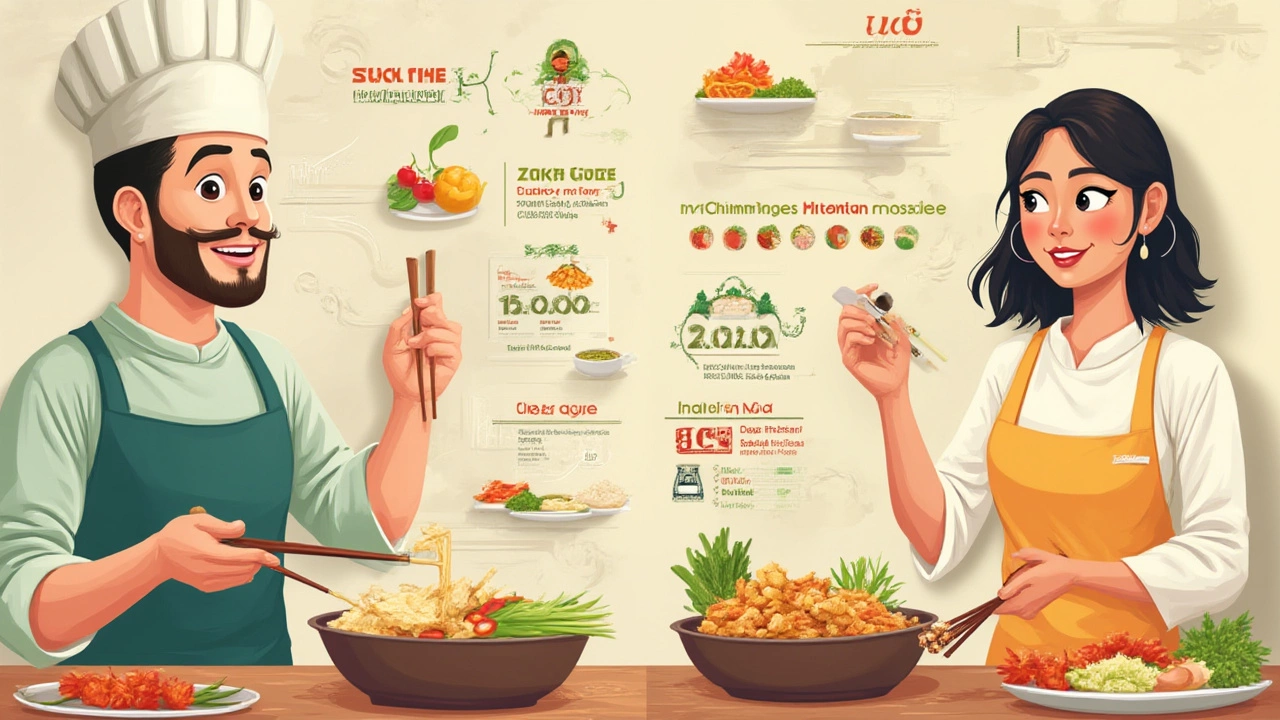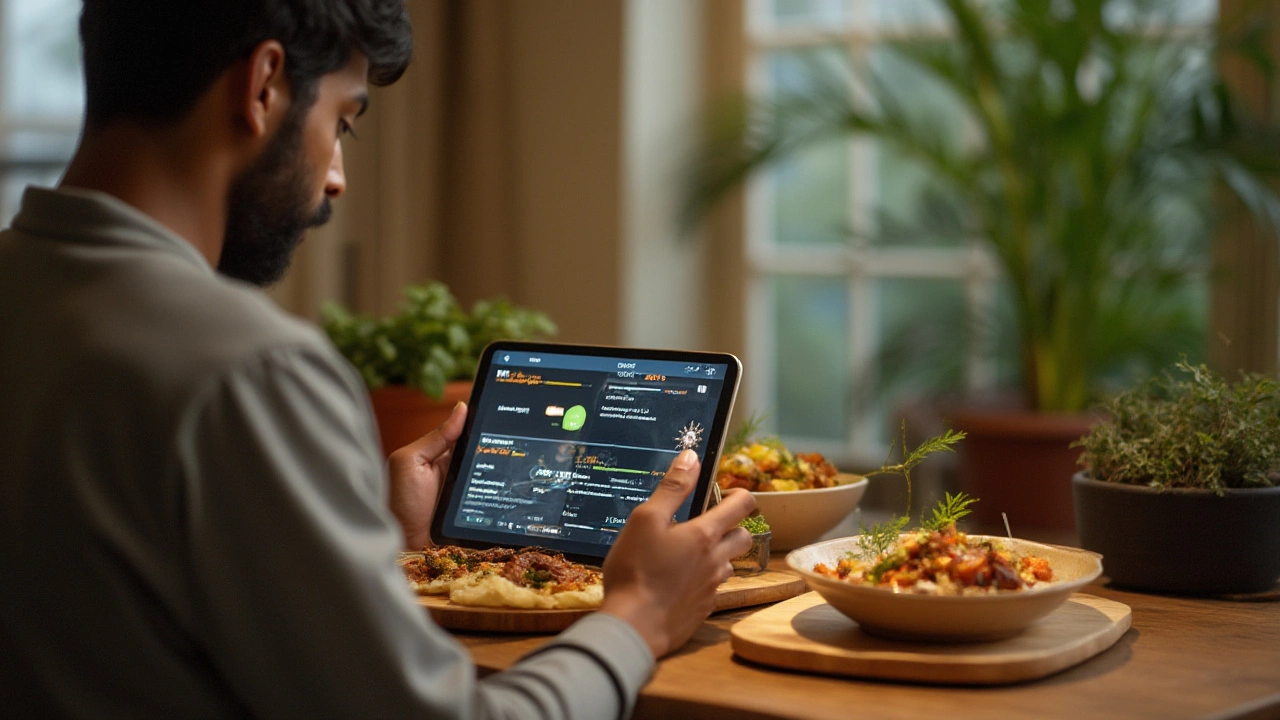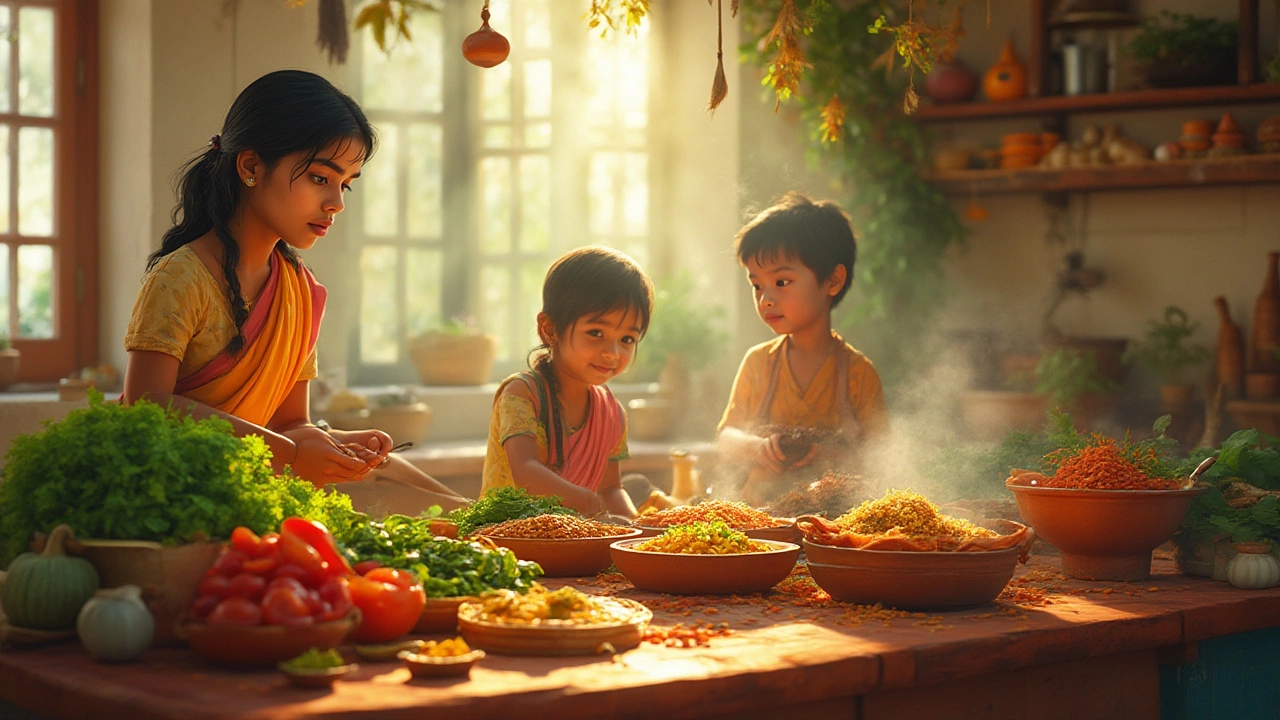Imagine this: you’re staring at a menu, torn between dal tadka and kung pao chicken. Both sound tempting, but one question nibbles at your brain—what’s actually healthier? Picking between Indian and Chinese food isn’t just about flavor but also about what’s going into your body, how it’s made, and how it fits into your life. Lately, more people want food that’s not just tasty but honest-to-goodness good for you. The twist? Both cuisines are older than most countries, rich with culture, and loved the world over, but they play by different rules when it comes to healthiness. Let’s pull apart the layers—spices, sauces, oils, and all—and settle this delicious debate.
The Real Ingredients: What’s Actually Going Into Indian and Chinese Food
If you’ve cooked at home or peeked inside a restaurant kitchen, you know the ingredients make all the difference. Indian food is famous for its wild range of spices—think turmeric, cumin, black mustard seeds, cinnamon, cardamom, fenugreek, and more. These aren’t just there to jazz things up. Turmeric, for example, has curcumin, which some real studies show fights inflammation. Ginger and garlic are strong contenders for boosting immunity and helping your gut.
But let’s talk about fats. Traditional Indian cooking calls for ghee—clarified butter—which packs more flavor than plain butter but is still mostly saturated fat. Lentils, chickpeas, vegetables, and whole grains like brown rice or chapati are common, giving you good protein, fiber, and B vitamins in a simple meal. For every creamy tikka masala, there’s a hearty bowl of dal—low in fat, high in protein, and full of iron.
It’s not all sainthood though. A lot of Indian food, especially restaurant or catered dishes, use lashings of oil and cream. Think of that party butter chicken swimming in orange gravy—delicious but full of calories and cholesterol.
Now, look at Chinese food. It swings across China—there’s Cantonese, Sichuan, Hunan, Shanghainese; each region has its own style. The staples are veggies (bok choy, napa cabbage, snow peas), lean proteins (chicken, tofu, shrimp), whole grains (yes, brown rice shows up if you ask), and soy-based flavor boosters.
Most traditional Chinese dishes are steamed, blanched, or stir-fried quickly—locking in nutrients and using little oil. Steamed dumplings, for example, use thin wrappers and fillings full of greens or lean pork. In fact, the Chinese diet, according to a big 2019 study published in the Lancet, is lower in saturated fats and animal protein than a typical Western diet but has high levels of plant proteins and stir-fried vegetables.
Still, Chinese takeout as we know it outside China isn’t all steamed fish and greens. Many famous dishes (orange chicken, sweet and sour pork) are battered, deep-fried, and then doused in sugary sauces with MSG and heaps of salt. Sodium intake? A single American-style serving of General Tso’s chicken can pack over 2,300mg of sodium—that’s already your entire recommended daily max, according to the American Heart Association!
There’s also the soy sauce factor. One tablespoon holds about 900mg of sodium. Multiply that by a few saucy dishes and you’ll notice some serious bloating or thirst later. If there’s one thing to really keep an eye on in Chinese food, it’s the sodium and added sugar in restaurant-style meals.
| Typical Dish | Calories (per serving) | Fat (g) | Sodium (mg) | Protein (g) |
|---|---|---|---|---|
| Indian Dal with Rice | 320 | 6 | 400 | 13 |
| Butter Chicken (restaurant) | 490 | 29 | 700 | 25 |
| Chinese Steamed Vegetables & Tofu | 270 | 9 | 650 | 16 |
| General Tso’s Chicken | 890 | 40 | 2300 | 34 |
Looking at the table, the difference is clear—basic home-cooked Indian and Chinese dishes can be healthy, but if you choose the Americanized deep-fried or creamy stuff, your waistline and blood pressure will notice. Making smart picks is everything.

Health Habits and Hidden Risks: What the Numbers and Science Say
People sometimes think all Asian food is healthy—it’s not that simple. Chronic diseases like type 2 diabetes and heart disease are linked to what lands on your plate, and both cuisines have their own red flags.
Let’s start with Indian food. India leads the world in living with diabetes, but weirdly, people there don’t eat a ton of sugar compared to Americans. The culprit? Refined starch like white rice and white flour (maida), and too much oil. Deep-fried samosas, poori, bhatura, and piles of basmati rice can nudge blood sugar up for anyone. Studies from India’s National Diabetes, Obesity and Cholesterol Foundation spell it out—switching to whole grains (brown rice, millet, whole wheat) and using less oil knocks down the risk of developing diabetes by up to 30% over ten years.
On the bright side, when you pick meals like rajma (kidney beans), chana masala, or baingan bharta (eggplant), you get a party of plant fiber, antioxidants, and healthy fats—especially olive oil or mustard oil instead of ghee.
Chinese cuisine’s hidden trick is salt. The Chinese Health and Nutrition Survey showed that adults in China eat nearly double the WHO’s sodium recommendation, mostly from sauces and preserved products. High sodium pushes blood pressure through the roof, especially if you regularly chow down on soy sauce, black bean paste, or preserved meats. There’s also evidence—Harvard’s School of Public Health covered this—linking high sodium diets to an increased stroke risk in East Asia.
Still, Chinese food, when done right, wins for the sheer amount of veggies. Bok choy, spinach, mushrooms, bell peppers, bamboo shoots, bean sprouts, broccoli—it’s hard to find a dish without greens. That means more fiber and more micronutrients like vitamin C, folate, and potassium, all helping you dodge chronic illness and improve digestion.
Let’s get practical. Want healthy Indian food? Go for home-style dishes, cut down on ghee, skip the fried stuff, and load up on lentils and veggies. Don’t just pick naan and butter chicken. Opt for brown rice or millet, and swap yogurt-based raita for heavy cream toppings.
With Chinese, the rules are simple: avoid anything breaded or deep-fried, ask for steamed or stir-fried with little oil, use light sauce, and ask for less salt or soy sauce. Restaurants will often listen. Order a side of steamed veggies, and pass on the fortune cookies—they’re pure sugar, no fortune involved.
And don’t forget drinks. Chaas (spiced buttermilk) or green tea? Both are low-calorie, hydrating, and add nutrients. But Indian sweet lassi and Chinese bubble tea? Sugar bombs in a glass, save them for rare treats.

Smart Swaps, Surprising Hacks, and Healthy Picks
Craving Indian or Chinese tonight? You don’t have to give up flavor for health if you know what to order, cook, or swap. Let’s break it down.
- Pick protein and fiber: Whether you’re vegetarian or love your meat, there’s room for both. Indian dals (lentil soups) are pure plant protein. Chinese tofu and egg dishes add protein without the saturated fat of red meat.
- Choose whole grains: Ask for brown rice or roti (whole wheat bread) in Indian meals. In Chinese, request brown rice, quinoa, or skip the rice and ask for double veggies.
- Be choosy with sauces: Indian dishes like saag (spinach-based) keep cream out by using pureed spinach and spices. Ask for ‘less butter’ or ‘no cream’ when ordering. In Chinese restaurants, request ‘light sauce’ or sauce on the side—trust me, it’s a game changer.
- Hack your cooking oils: Replace ghee or vegetable oil with olive or mustard oil for Indian dishes at home. For Chinese stir-fries, use minimal oil and high heat for a quick-cooking crunch.
- Get creative with spices: Cardamom in curries or star anise in stir-fry doesn’t just add flavor; a lot of spices have proven anti-inflammatory powers. Use them instead of piling on salt.
- Read between the lines: Buffets and fast food joints are usually where healthy intentions go to die. Go for small portions, don’t drown your food in sauces, and always load up on side salads or extra veggies.
- Learn from grandma: Traditional Indian and Chinese homes cook with more veggies, less oil, and no added sugar. They waste nothing—leftover dals morph into breakfast parathas and steamed buns get stuffed with yesterday’s stir-fry.
Don’t forget mental health. The act of eating together is big in both cultures. A 2021 survey in India found folks who had home-cooked meals with family at least four times a week reported better digestion, less stress, and even a slimmer waistline. In China, shared dishes and slow meals build better habits—they force you to eat slower, appreciate your food, and watch portions without even thinking about it.
Curious how I eat? My partner Kieron and I have a trick: we mix and match. Red lentil dal with a light chicken stir-fry or steamed fish with a warm bowl of rajma. We keep sodium low, say no to creamy curries, and always, always have sliced cucumber or a plate of simple cabbage stir-fry on the side. Dessert? Fresh mango or lychees. Never the deep-fried kind.
So which is healthier—Indian or Chinese food? Turns out, both have amazing potential if you stick to basics, play up the veggies, use healthy oils, and treat rich dishes as special occasion treats. Instead of picking a side, take the best from both worlds. Eating well isn’t about choosing a single flag—mix in wisdom from different plates, and your body (and taste buds) will thank you.
